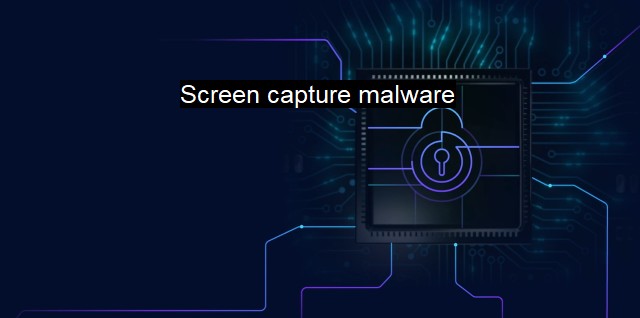What is Screen capture malware?
Inside Screen Capture Malware: The Increasing Threat to Sensitive Information
"Screen capture malware" is a type of malicious software that infiltrates a computer system, typically without the user's knowledge, with the intent to capture the activities presented on the screen, including keystrokes and mouse movements. this type of malware plays a significant role as one of the primary threats to the confidentiality, integrity, and availability of information and services.The fallout from screen capture malware can be severe, as it’s often utilized by cybercriminals for shady activities such as identity theft, financial fraud, or corporate espionage. The criminals behind this malware can easily take screenshots of your personal data, finances, passwords, or any work-related information and use it for malevolent purposes.
Screen capture malware functions in a hidden stealth mode and exploits the weaknesses within a computer system or manipulates user actions often to facilitate its payload delivery. It can gain entrance into your system via malicious downloads, infected email attachments, drive-by downloads, or even through clicking on an infected ad or website.
Once inside the system, the malware sets up a background process that can record whatever happens on the victim's screen. This may include the typing of usernames and passwords for bank accounts, sensitive work files, personal messages, emails, or even social media posts. The malware then encodes these screen captures and sends them off to a remote server wherein a cybercriminal can access, review, and exploit the captured data.
Protection against screen capture malware forms an essential aspect of cybersecurity. Antivirus software can play a vital part in protecting systems from this kind of threat in several ways. Regular scanning of system files can help identify any suspicious applications or processes that may be the result of an infection.
Most antivirus software recognize the signatures of known malware types and can act to neutralize the threat before it completes its objective. Even if the malware is unknown or a zero-day threat, advanced antivirus solutions use behavior-based detection techniques to identify unusual behavior patterns that suggest a malware attack.
In addition to antivirus software, users can take different measures to add layers of security. Using firewall technology creates a defensive barrier between the user's computer and potential online threats. Frequently updating your operating system, applications, and security software can patch vulnerabilities that might be otherwise exploited by criminals. Cyber hygiene measures such as enabling multifactor authentication, encrypting sensitive data, and refraining from opening suspicious emails or visiting insecure websites can also deter the likelihood of virus infections.
Meticulous safeguarding practices combined with reliable antivirus software can help not only in unwittingly becoming a victim but also in effectively dealing with a screen capture malware attack if it does occur. Individuals and businesses must commit to building and maintaining a robust defensive cybersecurity posture against this significant threat to privacy and security.
The threat presented by screen capture malware is a substantial one, affecting both individuals and corporate entities alike. While its repercussions can be quite damaging, including loss of sensitive information and potential financial losses, with alertness, timely digit hygiene practices, and the support of advanced antivirus software, it is a challenge that can be efficiently addressed and overcome. It tells us that cybersecurity is never a one-time event but an ongoing process. Therefore, constant vigilance, informed safety practices, and the use of comprehensive security solutions are necessary for effective protection against screen capture malware and other digital threats.

Screen capture malware FAQs
What is screen capture malware?
Screen capture malware is a type of malicious software that captures screenshots of the victim's device screen and sends them to the attacker. This malware can capture sensitive information such as login credentials, bank account details, and personal data.How does screen capture malware infect a device?
Screen capture malware can infect a device through various means, such as downloading infected files or opening infected email attachments, clicking on malicious links, and downloading fake software updates.What can I do to protect my device from screen capture malware?
Some steps you can take to protect your device from screen capture malware include installing antivirus software, keeping your operating system and software up-to-date, avoiding suspicious email attachments and links, and being cautious when downloading software from untrusted sources.What should I do if I think my device is infected with screen capture malware?
If you suspect that your device has been infected with screen capture malware, you should immediately disconnect from the internet, run a full system scan with your antivirus software, and change your login credentials for all important accounts. If the malware is persistent, it may be necessary to seek the help of a cybersecurity professional.| | A | | | B | | | C | | | D | | | E | | | F | | | G | | | H | | | I | | | J | | | K | | | L | | | M | |
| | N | | | O | | | P | | | Q | | | R | | | S | | | T | | | U | | | V | | | W | | | X | | | Y | | | Z | |
| | 1 | | | 2 | | | 3 | | | 4 | | | 7 | | | 8 | | |||||||